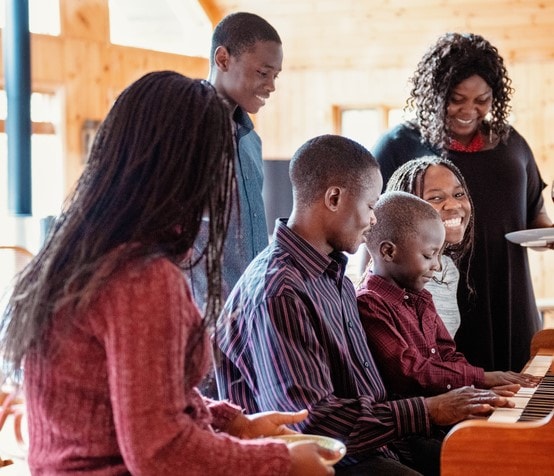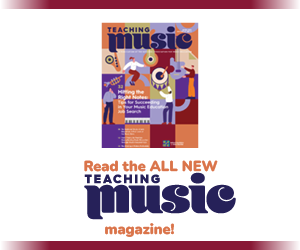/ News Posts / Music: A Powerful Tool for Family Engagement
Music: A Powerful Tool for Family Engagement
By Dr. Lili M. Levinowitz,
Professor Emeritus, Music Education, Rowan University
Director of Research, Music Together Worldwide
Sponsored by Music Together Worldwide
Elementary general music teacher Ms. Muhler* had vivid childhood memories of making music around the piano with family members of many different ages. These times were so meaningful to her; when she started teaching, she was surprised to find that not many of her students were having the same experience.
So Ms. Muhler decided that she would find a way to act as a catalyst for family music-making, while also facilitating a bridge between school and home. Every week, she sent home a flyer specific to each grade level, where she wrote, “Sing along and dance with me while I sing ____________,” with a short explanation about the objectives for music-learning based on the song.
In her quest to encourage more families to make music at home, Ms. Muhler also created a powerful, simple tool to foster family engagement! The weekly flyers facilitated conversations with families, and helped parents understand that her job had real intent to grow their child’s music capacities. (That is, it was more than “singing and dancing all day”!) Best of all, Ms. Muhler learned that families looked forward to her communications each week—and that they were making music at home!
Family Engagement with Music
Most educators wholeheartedly agree on the importance of family engagement—and have seen its positive effects firsthand. And, as a music teacher, you know that music can help make family engagement easier (and more fun!). Yet, it can also be a challenge. Busy moms and dads may not realize that participation in musical school life can significantly impact their child’s learning, or they may feel unable—or unqualified—to participate. One solution is for music teachers to find ways to develop enjoyable, accessible activities that make it easy for parents to engage, like Ms. Muhler’s flyers.
The easy activities can also encourage classroom teachers to feel more comfortable using music as part of everyday learning Ms. Muhler also discovered that sharing her take-home flyers with classroom professionals encouraged them to use some of the music activities in their own classrooms, to support their curriculum. They even began advocating for at-home music-making as a fun way for students to practice and gain mastery of math concepts, language development, and social-emotional and other cognitive skills.
Anywhere, Anytime Learning
The Harvard Family Research Project (HRFP) classifies parent-child interactions such as singing songs and sharing stories as fundamental, “anywhere, anytime learning” activities. “Families are important in helping children uncover and expand [their] interests and in encouraging them to try out new paths to learning . . . These parent-child activities need not take place only at home or school, but can occur at the grocery store, the laundromat, or anywhere and anytime children and families are together.”[i] As music is inherently portable, it is an ideal anywhere, anytime learning tool!
- Families don’t need anything but their voices, bodies, and brains to sing a song or play a rhythm game. When music teachers give parents song games to play, learning can happen at the kitchen table, in the car, or at the grocery store. Songs about counting or colors can help pass the time during a traffic jam or make vegetable shopping more enjoyable (in addition to anchoring core school concepts and supporting music development!).
- Every new song or chant can deepen the home-school connection. A teacher can send home one song for extending the vocal range, another that engages audiation by leaving parts of the song out. You could also send home songs that support the curriculum goals of your classroom teacher colleagues. The novelty of each additional song game can refresh a parent’s school engagement while simultaneously serving as a playful way to practice music skills for your students (and their parents!).
- Songs and song games also give parents and caregivers a toolset that supports adult-child relationships while lowering stress. The heightened connection that comes from singing and dancing together supports sensitive-responsive interactions, helping parents tune into and meet children’s needs more effectively. Music can also help families execute daily routines and facilitate activity transitions, like moving from playtime to clean-up time, and then finally to bed.
Building Community through Music
Ms. Muhler anticipated that her take-home flyers and cooperation with classroom professionals would help her “get the word out” about important music skills and knowledge that supported her curriculum goals. She also hoped that it would result in more spontaneous at-home music-making and learning.
What she didn’t predict was that her classroom colleagues would spontaneously start singing together in the hallways, on the playground, at pickup time. Nor did she predict that students’ favorite songs would become part of their family identity and be shared with the extended family at family celebrations. The music activities that Ms. Muhler worked on in her music classroom ended up contributing to a deeper sense of belonging, connection, and community—a surprising fringe benefit!
Tips for Engaging Families through Music
Music’s inherent anywhere, anytime qualities make it a powerful tool for teachers at school and families at home to create high-quality, holistic educational experiences that are natural, playful, and support children’s music development and development in other domains.
When music teachers collaborate with classroom professionals, music can be an enjoyable way to reinforce classroom learning that creates a school-home connection and build a reciprocal relationship between families and the music teacher.
Sending home songs and rhythm games helps families to share the experience, making it a recipe for success to support music education and family engagement at the same time.
Here are some ideas you can try in your classroom or music program.
- Share your take home flyer ideas with your classroom professionals. Begin conversations that help them use the songs in their own classrooms to support their curricular goals and encourage them to talk to parents about how and why music can help their child’s learning.
- When possible, adapt songs and chants that families likely already know or can learn easily. See the idea below, using “Clap Your Hands” to encourage handwashing. The teacher who developed this idea did so because: 1) it’s an easy song to sing; 2) most adults in her community grew up hearing some version of that song; and, 3) she could share video links of the song for those who needed to learn it for the first time.
“Clap, Wash, and Rinse Your Hands”
The American folksong “Clap Your Hands” (Mixolydian tonality and duple meter) can be uniquely adapted for use when washing hands—something that we are all doing a lot with COVID-19! Instead of singing “Happy Birthday” twice while washing hands, sing this song by changing the lyrics to “Wash, wash, wash your hands, wash your hands, together,” then sing “rinse, rinse, . . . ” You could even get a timer out and estimate how fast or slow one needs to sing it to fill up 20 seconds!
- Sing songs at back-to-school night, family, and class events to informally teach the music to parents and classroom professionals. Most children spontaneously sing school songs at home and often in their school classroom and the playground, but family members and teachers who don’t know the songs tend not to sing along. By exposing parents and classroom professionals to songs from the music classroom music teachers increase the likelihood that families will more readily sing them at home.
- Make sure to send your take-home flyers on a regular basis so adult caregivers can anticipate them. Make sure to remind your students in music class what will be on the take-home flyer to foster excitement to bring the music home.
- Tell parents and caregivers why music is such an effective learning tool for children. Of course sending music home will support your music curriculum goals, but it is also an effective way to support learning in other domains that parents care about and are more familiar with, such as: 1) social-emotional learning, 2) cognitive development, 3) language development, and 4) physical development, along with the different approaches to learning.
- Send home photos, audio recordings, and video clips of children and teachers making music together in school. Documentation of in-school activities is a key part of family engagement in many school communities—the practice lets family members know what’s happening during the school day and gives them something to talk about and sing about after school. Including images or recordings of classroom songs has the added benefit of encouraging families to learn the songs and sing them together at home.
- Invite parents and caregivers to share at-home musical moments. Asking families to snap a photo or record an audio/video clip of children singing school songs with them at home—perhaps to be included in the children’s end-of-year portfolio—is a great way to foster singing music classroom songs at home.
- Host a class or school community event that includes singing songs, folk dances, and rhythm games used in the music classroom. To avoid the event becoming a “concert” (which can limit participation from parents and caregivers), make sure there’s no stage/elevated platform or microphones. Instead, just invite teachers and families to sing their favorite songs from music class together, sharing with each other and schoolmates.
- Use music apps to encourage even more “anytime, anywhere” family music-making. Apps like Hello Everybody include high-quality free music and a built-in karaoke function to make singing songs at home even easier. Sometimes parents who are less musically-confident appreciate this kind of additional support.
* Teacher’s name has been changed for privacy
[i] Lopez, M.E. and Caspe, M. (June 2014). “Family Engagement in Anywhere, Anytime Learning.” Harvard Family Research Project.
For more information:
Levinowitz, L.M. (May 2020). Supporting Families in Making Music at Home with Early Childhood Students [Webinar]. NAfME.
Levinowitz, L.M. (May 2020). Online STEAM Lesson Ideas for the K–2 Music Classroom [Webinar]. NAfME.
About the author:
 Lili M. Levinowitz, Ph.D. is Professor Emeritus of Music Education at Rowan University. She is the coauthor of the early childhood music and movement program, Music Together, and Director of Research for Music Together Worldwide. Dr. Levinowitz is considered a national authority on early childhood music and is actively involved in teaching very young children as well as presenting at national and international music education and early childhood education conferences. Her articles appear frequently in professional journals and popular magazines. She received her M.M. and Ph.D. from Temple University, and her B.M. from Westminster Choir College.
Lili M. Levinowitz, Ph.D. is Professor Emeritus of Music Education at Rowan University. She is the coauthor of the early childhood music and movement program, Music Together, and Director of Research for Music Together Worldwide. Dr. Levinowitz is considered a national authority on early childhood music and is actively involved in teaching very young children as well as presenting at national and international music education and early childhood education conferences. Her articles appear frequently in professional journals and popular magazines. She received her M.M. and Ph.D. from Temple University, and her B.M. from Westminster Choir College.
Did this blog spur new ideas for your music program? Share them on Amplify! Interested in reprinting this article? Please review the reprint guidelines.
The National Association for Music Education (NAfME) provides a number of forums for the sharing of information and opinion, including blogs and postings on our website, articles and columns in our magazines and journals, and postings to our Amplify member portal. Unless specifically noted, the views expressed in these media do not necessarily represent the policy or views of the Association, its officers, or its employees.
August 18, 2020. © National Association for Music Education (NAfME.org)
Published Date
August 18, 2020
Category
- Innovation
- Lifelong Learning
Copyright
August 18, 2020. © National Association for Music Education (NAfME.org)






